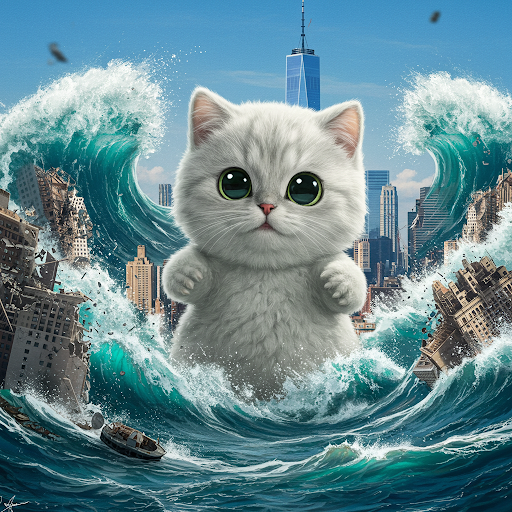
Oh No! Why Does My Cat Have a Swollen Eye?
Share
man
As a loving cat owner, there are few things more concerning than noticing a change in your feline friend's appearance or behavior. A swollen eye can be particularly alarming, and it's natural to feel worried. While it might look dramatic, understanding the potential causes behind a cat's swollen eye can help you determine the best course of action.
This blog post will explore some of the common reasons why your cat might be sporting a puffy peeper and when it's crucial to seek veterinary attention.
What Could Be Causing the Swelling?
A swollen eye in a cat can be a symptom of various underlying issues, ranging from minor irritations to more serious medical conditions. Here are some of the most frequent culprits:
-
Conjunctivitis (Pink Eye): This is a common inflammation of the conjunctiva, the thin membrane lining the inner eyelid and covering the white part of the eye. It can be caused by viral or bacterial infections, allergies, 1 or irritants. Along with swelling, you might notice redness, discharge (clear, yellow, or green), and increased blinking or squinting.
Corneal Ulcers or Abrasions: The cornea is the clear outer layer of the eye. Scratches, foreign bodies (like dust or plant material), or infections can damage the cornea, leading to inflammation and swelling. Your cat might also show signs of pain, excessive tearing, and sensitivity to light -
Trauma: Just like us, cats can experience eye injuries from fights with other animals, bumping into objects, or getting scratched by something sharp. Trauma can cause direct swelling, bleeding, and pain around the eye.
-
Foreign Bodies: A small object lodged in the eye, such as a piece of grass or an insect, can cause significant irritation, inflammation, and swelling. Your cat will likely paw at their eye and show signs of discomfort.
-
Allergies: Environmental allergens like pollen, dust mites, or mold can sometimes trigger allergic reactions in cats, leading to itchy, watery, and swollen eyes.
-
Dental Issues: Believe it or not, infections or abscesses in the upper teeth can sometimes cause swelling in the area around the eye. This is because the roots of some upper teeth are located close to the eye socket.
-
Abscesses or Infections: Infections in the skin or tissues surrounding the eye can lead to localized swelling, redness, and pain. This could be due to a bite wound, a scratch, or an embedded foreign object.
-
Glaucoma: This condition involves increased pressure inside the eye, which can lead to swelling, pain, and vision loss. It's a more serious condition that requires prompt veterinary attention.
-
Tumors or Growths: While less common, growths around or within the eye socket can cause swelling and other changes in the eye's appearance.
When is it Time to See the Vet?
While a minor irritation might resolve on its own, it's crucial to know when a swollen eye warrants a trip to the veterinarian. You should seek veterinary attention immediately if you notice any of the following along with the swelling:
- Significant pain or discomfort: If your cat is constantly pawing at their eye, squinting severely, or vocalizing in pain.
- Changes in vision: If your cat seems disoriented, is bumping into things, or doesn't react to movement.
- Excessive discharge: Especially if it's thick, yellow, green, or bloody.
- Redness of the eye or surrounding tissues.
- Cloudiness of the eye.
- Lethargy or loss of appetite.
- Any history of trauma to the eye.
What to Expect at the Vet's Office:
Your veterinarian will perform a thorough eye examination, which may include:
- Visual inspection: Checking for redness, discharge, foreign bodies, and any obvious abnormalities.
- Fluorescein stain test: A harmless dye is applied to the eye to check for corneal ulcers or abrasions.
- Tonometry: Measuring the pressure inside the eye to check for glaucoma.
- Schirmer tear test: Assessing tear production to rule out dry eye.
- Blood tests: To check for underlying infections or systemic issues.
- Imaging (in some cases): X-rays or CT scans might be necessary to investigate deeper issues.
Treatment Options:
The treatment for your cat's swollen eye will depend entirely on the underlying cause. It might involve:
- Topical medications: Antibiotic or antiviral eye drops or ointments for infections.
- Oral medications: Antibiotics, antifungals, or anti-inflammatory drugs.
- Pain relievers: To manage discomfort.
- Surgery: In cases of severe trauma, foreign body removal, or tumor removal.
- Medications to lower eye pressure: For glaucoma.
Never attempt to treat your cat's swollen eye with over-the-counter human medications. These can be harmful and may worsen the condition. Always follow your veterinarian's instructions carefully.
In Conclusion:
A swollen eye in your cat can be a sign of various health issues, some more serious than others. By being observant and knowing when to seek professional veterinary care, you can help ensure your feline friend receives the appropriate diagnosis and treatment for a swift and comfortable recovery. Don't hesitate to contact your vet if you have any concerns about your cat's eye health – their vision and comfort are worth it!
